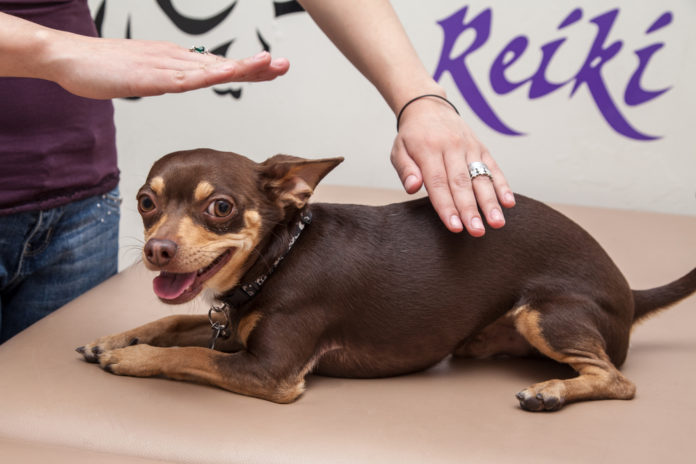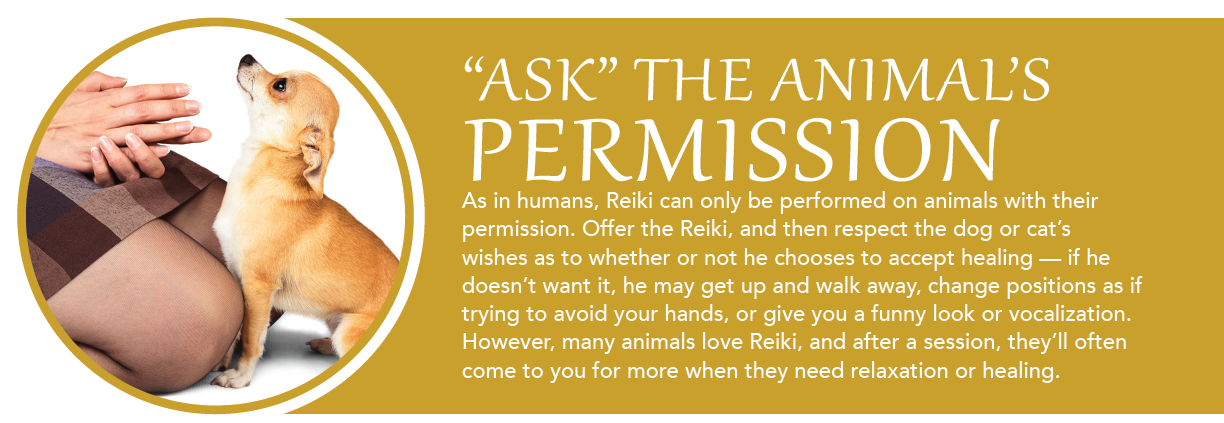Animal Reiki — attracting more attention as a healing modality

Once dismissed as bogus, Reiki is being brought into shelters, veterinary clinics and other animal facilities as an effective way to enhance healing and well-being in dogs and cats.
Gone are the days when we naively believed there was a “pill for every ill”, and when veterinary medicine was primarily reactionary. Now, both dog and cat parents and veterinarians agree that the key to longevity in companion animals is disease prevention combined with early detection and treatment. To support this goal, more animal parents and professionals alike are turning to alternative modalities to help support canine and feline health and well-being. One example of these modalities is Reiki. Once regarded as little more than “woo-woo”, Reiki for animals is now finding its way into a variety of professional settings, from shelters to vet clinics.
What is Reiki and what does it do?
Reiki is an energy healing system that channels universal life energy through a practitioner’s hands along energetic pathways, thereby healing on physical, mental, emotional and spiritual levels. The energy is directed by intention from the healer to the receiver, be it a person or animal. Practitioners do not take credit for healing, and they are also not responsible if healing does not take place. They merely act as a conduit, allowing the intelligent energy to flow where it is most needed by the receiver.
Most Reiki practitioners believe that all physical pain has non-physical roots in emotional trauma, negative mental patterns, or spiritual despair. During a healing session, the healer moves her hands as she feels different sensations; how long the hands need to stay in different positions depends on the session. The healer and the receiver cannot specify where the energy will go or what it will heal first. The energy goes where it is needed. Reiki will heal the oldest traumas first, removing the manifestations of the disease by its roots. For chronic conditions that are the product of time, multiple sessions may be required.
Where did it come from?
Most Reiki schools acknowledge Dr. Mikao Usui as the founder of modern Reiki, although many believe this form of healing dates back thousands of years. The legend goes that Dr. Usui, a Japanese university professor in the 1800s, was asked by his students to demonstrate the method by which Jesus did his healing. His journey to answer this question took him on a ten-year quest that explored Christian and eventually Buddhist traditions. However, it’s important to remember that this healing modality is not a religion, nor is it affiliated with any religion.
The birth of Reiki for animals
In 1995, Diane Stein wrote a book called Essential Reiki, which introduced Reiki to the mainstream Western world for the first time. Stein believed in making Reiki accessible and affordable, and in demystifying this universal healing system. While she briefly acknowledges the role this modality can play in animal health, it was Elizabeth Fulton and Kathleen Prasad’s book Animal Reiki, published a decade later, that truly introduced Reiki as a viable healing modality for animals.

Benefits of giving Reiki to animals
Reiki can induce deep relaxation and stress reduction, and benefits nervous or stressed animals, which is why it is often practiced in shelters. It is also often used in end-of-life care; it can ease the dying process for both animals and their caregivers.
There is no downside to using Reiki as a complementary treatment modality for dogs and cats. It is gentle, painless, non-invasive — and as long as proper consent and technique is used (see sidebar above) — stress-free and safe for animals. Reiki’s healing energy will go where it is needed in the dog or cat’s body and can be used from a distance, making it ideal for animals in a variety of settings such as veterinary clinics, grooming centers, rescues, shelters or training facilities.
 Using this modality in shelters
Using this modality in shelters
Reiki can be very successful when used in shelters, and is being used more often in these settings. In 2008, Kathleen Prasad and Leah D’Ambrosio founded the Shelter Animal Reiki Association (SARA), a non-profit organization whose goal is to create peaceful healing environments at shelters and other animal care settings through the use of this modality.
Carolyn, a Level 2 practitioner, uses Reiki in combination with flower essences in animal shelters. She is also an experienced dog trainer and is often called when an intractable aggressive dog is in danger of being euthanized. Prior to arriving at the shelter, Carolyn performs self-healing Reiki and then a distance healing, sending the energy out with intention to the dog. Most of the time, after she arrives at the shelter, the out-of-control dog is sitting patiently, waiting for her at the kennel door to start the session.
Reiki in veterinary clinic settings
Veterinary medicine is vital to an animal’s health and wellness, but it sometimes falls short of providing full answers to the mental, emotional and physical well-being of animal patients. Complementary or integrative medicine, which combines Western and alternative techniques, such as Reiki, work together well to keep our dogs and cats well.
With this in mind, a growing number of integrative and holistic veterinarians are incorporating Reiki into their practices to help support the well-being and healing of their canine and feline patients. The AVHMA website currently lists nearly 140 holistic veterinarians in the US and Canada who offer Reiki as one of their modalities.
When choosing a practitioner to work with your dog or cat, select someone who has experience and trains often, since both practicing and receiving Reiki energy is believed to deepen the practitioner’s understanding, which means the healing becomes more guided. Used in conjunction with a trusted veterinarian, a Reiki practitioner may benefit your animals and help him to stay healthy for years to come.
The author would like to thank practitioner, Carolyn Niehaus of AnimalSave, for sharing her expertise for this article.



